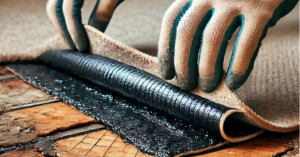What is Asbestos and Why is it Dangerous?
Asbestos is a naturally occurring fibrous mineral that was widely used in residential and commercial construction before the 1970s. It was favored for its resistance to heat, fireproofing properties, and its ability to add structural strength to building materials. Asbestos-containing materials (ACMs) were commonly used in insulation, roofing, flooring, and even household items.
Although asbestos began to be regulated in the 1970s due to growing health concerns, stockpiles of asbestos materials held by contractors and builders meant that ACMs continued to be used in construction well into the 1980s and potentially later. This extended use has left many homes and buildings containing asbestos today.
The danger of asbestos arises when these materials are disturbed, as they release microscopic fibers into the air. These fibers are small enough to be inhaled, and because of their durability, they can lodge in the lungs or other parts of the body for decades, leading to severe health issues.
Health Risks of Asbestos Exposure
The real danger of asbestos lies in its long-term health effects. Once inhaled, asbestos fibers can remain in the lungs for life, leading to serious diseases that often do not manifest until years or even decades after exposure. The three most commonly associated diseases are:
- Mesothelioma: This is a rare and aggressive form of cancer that affects the lining of the lungs (pleura), chest, abdomen, or heart. Unlike other cancers, mesothelioma is almost exclusively caused by asbestos exposure. Tragically, by the time symptoms appear, the disease is often in its advanced stages, making treatment difficult. Mesothelioma has claimed the lives of many, including actor Steve McQueen, who believed his illness was caused by exposure on movie sets.
- Lung Cancer: Long-term exposure to asbestos significantly increases the risk of developing lung cancer. Even for non-smokers, the inhalation of asbestos fibers can cause scarring and lead to malignant tumors in the lungs. The combination of asbestos exposure and smoking further elevates the risk.
- Asbestosis: This chronic lung disease results from prolonged exposure to asbestos fibers, which cause scarring in the lung tissue. The buildup of scar tissue can make breathing increasingly difficult and can severely limit lung function over time. Unlike mesothelioma or lung cancer, asbestosis is not a cancer, but it is still a life-threatening condition that can dramatically reduce quality of life.
Famous Examples of Asbestos Exposure


Asbestos was widely used beyond construction and into everyday products, including textiles, automotive parts, and even movie sets. One of the most infamous examples is from The Wizard of Oz, where asbestos “snow” was used during the poppy field scene to simulate snowfall. At the time, the dangers of asbestos were not well known, and actors and crew members were routinely exposed to these fibers. Many actors from that era later developed severe asbestos-related illnesses or passed away due to related diseases.
Another tragic example comes from the shipbuilding industry, where asbestos was heavily used for insulation and fireproofing in naval ships during World War II. Thousands of veterans who worked in shipyards or served aboard these ships were exposed to asbestos, and many later developed diseases like mesothelioma or lung cancer.
Latency Period and Fiber Size
One of the most insidious aspects of asbestos-related diseases is the latency period, which can range from 20 to 50 years after initial exposure. This means that individuals may not develop symptoms until decades later, making early detection nearly impossible. By the time a diagnosis is made, the disease is often advanced and difficult to treat.
Asbestos fibers are extremely small, measuring up to 700 times thinner than a human hair. Their tiny size makes them invisible to the naked eye, yet they are easily inhaled and can penetrate deep into the lungs. Once lodged in the lung tissue, these fibers remain there for life, causing chronic irritation, inflammation, and scarring that can eventually lead to disease.
Common Asbestos-Containing Materials in Homes
If your home was built before 1980, asbestos may be present in a variety of materials, including:
- Popcorn ceilings: Often used for soundproofing and texture.
- Vinyl flooring and adhesives: Many vinyl tiles and their adhesives contained asbestos for added durability.
- Roof shingles and siding: Asbestos was commonly mixed into cement products for added fireproofing and strength.
- Pipe insulation: Used to insulate pipes, boilers, and ductwork.
- Cement asbestos boards: Frequently used in walls, roofing, and underlayment in older homes.
Even though asbestos is not dangerous when undisturbed, normal wear and tear or home renovations can cause these materials to degrade and release harmful fibers into the air.
Why is Asbestos Particularly Dangerous to Children?

Children are especially vulnerable to the harmful effects of asbestos. Due to their smaller size, they breathe more rapidly than adults, inhaling more air—and potentially more asbestos fibers. Additionally, children have more time ahead of them for asbestos-related diseases like mesothelioma or lung cancer to develop, as these conditions often take decades to manifest.
How to Safely Handle Asbestos in Your Home
1. Never Disturb Suspected Asbestos
The number one rule for asbestos safety is: do not disturb it. Even minor actions such as drilling, sanding, or scraping can release dangerous fibers into the air. If you suspect that a material in your home contains asbestos, it’s crucial to avoid any contact and leave the area undisturbed.
2. Contact Certified Professionals
Asbestos testing and removal should only be handled by certified professionals. These experts have the training and equipment to safely:
- Test the suspected materials.
- Assess the risk of exposure.
- Remove or encapsulate the asbestos without releasing fibers into the air.
Legal and Health Risks of DIY Asbestos Removal
Attempting to remove asbestos yourself is not only dangerous but illegal if not done properly. Federal and local regulations require specific protocols for asbestos handling, and fines can be issued for violations. Improper removal can also lead to unintentional exposure, putting your family and neighbors at risk. Furthermore, homeowners can be held liable if asbestos fibers spread, exposing others to this deadly substance.
What to Expect During Asbestos Abatement
If you hire a professional asbestos abatement company, the process generally includes:
- Inspection and testing of the suspected materials.
- Containment of the work area using proper barriers and ventilation systems to prevent fibers from spreading to other parts of the home.
- Removal or encapsulation of the asbestos-containing materials.
- Post-removal testing to ensure the air is safe for re-occupancy.
During the abatement, the team will use HEPA filters, negative air machines, and other specialized equipment to ensure that fibers are contained and removed safely.
Final Thoughts: Protecting Your Home and Family
If you suspect asbestos in your home, it’s critical to leave it undisturbed and contact a professional for testing and abatement. Although asbestos fibers are invisible, they can have devastating long-term effects on your health. Always avoid DIY removal and rely on certified experts to ensure your home and family remain safe from this hidden danger.
Disclaimers:
This article is for educational purposes only. Homeowners should always seek professional assistance when dealing with asbestos.
Green River Asbestos Abatement is not liable for any actions taken based on the information in this article. Always contact licensed professionals for testing and removal.





